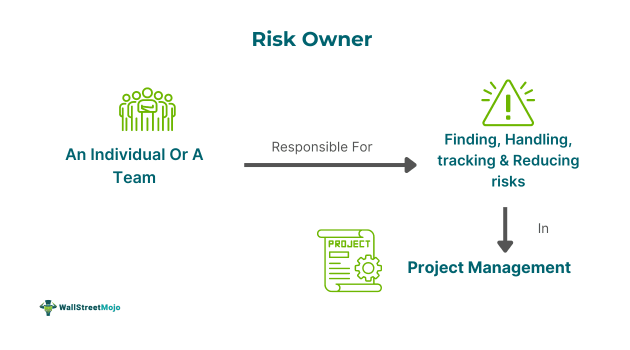Table Of Contents
Risk Owner Definition
Risk owner refer to individuals or a team in project management entrusted with finding, handling, tracking, and reducing risks in a project. They are accountable for the effective implementation and monitoring of strategies to reduce risk impact on project goals by delegating responsibilities to action owners.

A designated risk owner is assigned to every identified and recorded risk. They are responsible for handling the related risk using the ensuing project risk management procedures. They must choose economical, doable, and appropriate strategies related to every single risk as per their characteristics and evaluated priority.
Key Takeaways
- Risk owner is a team or an individual responsible for identifying, managing, and reducing risks assigned to them in projects.
- They ensure effective execution and monitoring of strategies to minimize project risk impact on project objectives through delegation of responsibilities
- They must develop mitigation strategies, assist risk managers, understand, assess, and articulate risks, and regularly scan emerging environments for project-related risks while adhering to cutoffs.
- They are accountable for only the single risk and associated opportunities assigned to them, while risk managers are responsible for all types of risks concerning a project.
Risk Owner Explained
The risk owner is the person or team accountable for ensuring that the correct risk response strategy is chosen and executed. Their role is crucial for achieving better project management outcomes.
A risk owner in project management is responsible for identifying risks and describing them in detail to facilitate their assignment to specific individuals. Additionally, trigger conditions should be identified whenever possible. Once assigned, these individuals or teams choose appropriate strategies based on the risk's priority and nature, considering both feasibility and cost-effectiveness.
Moreover, a senior information risk owner may delegate these responsibilities to action owners, ensuring proper implementation and accountability. For a broader perspective on risk management, risk owner definitions ISO 31000 and ISO 27001 can be consulted, offering valuable insights into risk ownership and management practices.
Afterward, actions to execute the selected strategies and track their effectiveness must be defined. As standard procedure, the individual or team identifies secondary risks and ensures that all response actions and strategies are documented and communicated. Assigning clear ownership of individual risks ensures accountability and supports effective risk management. This clarity also streamlines decision-making and improves project efficiency.
The roles of risk owners and action owners guarantee a systematic approach to risk management by promoting accountability and transparency among project stakeholders. This structured approach is precious in financial projects, where meticulous risk management is essential to prevent financial losses and keep the project on track. Additionally, effective communication between the project manager, risk owners, and action owners is critical for successful project execution.
Roles And Responsibilities
Their main roles and responsibilities are listed below:
- They should have the capability to comprehend the risk, its root causes and its respective impact
- Monitoring and assessing identified risks
- Articulating the impact and causes of risks pertaining to risk statements clearly
- Defining measures of risk and tolerance
- Develop strategies regarding risk mitigations
- Assisting risk managers related to the execution of risk mitigation strategies
- Scanning enterprising environments concerning emerging risks regularly
- They should be able to deal with project-related risks
- They must abide by the cutoffs as defined under the risk mitigation plan
- They must respond quickly to risk that turns into a problem
- They should be able to find and locate even the slightest risk changes
Examples
Let us go through a few examples to understand the topic better:
Example #1
Imagine a software company, Softech Limited, has been developing a new mobile banking app for its client banks. The project of that app has the following owners of risk (OR):
- Security OR- locates, evaluates, and mitigates security threats like fraudulent access to customer data.
- Technical OR- oversees any outages or technical glitches arising in the app that prevent users from using their banking accounts.
- Compliance OR- guarantees that the app complies with all the important financial regulations. They also locate and resolve any potential adherence issues before the app launches.
This strategy contributed to effective project risk management. As a result, the app was successfully launched and attracted a large number of users in the market.
Example #2
An article published online on November 3, 2023, discusses the guidance for transforming to post-quantum cryptography, which aids systems and owners of risk throughout various industries, such as critical infrastructure providers, public organizations, and commercial enterprises. It helps in getting ready for the transformation to post-quantum cryptography (PQC).
The article also advises choosing PQC protocols and algorithms specifically concerning systems with unique IT or operational technology setups. It states that risk and system owners are motivated to initiate financial planning related to system updates and use PQC that align upgrades with normal technology refresh cycles.
Risk Owner Vs. Risk Manager
Risk owner
- They are accountable for only the single risk and associated opportunities assigned to them.
- They have to define the risk assigned to them.
- They have to develop unique strategies to mitigate the risk designated to them.
- They have to adhere to the deadline and financial constraints outlined in the strategy of risk mitigation.
- They are responsible for offering the current risk status to the risk manager.
Risk manager
- They have to bear the responsibility for all types of risks concerning a project.
- They have to offer an overall view of a project.
- They promote cooperation and buy-in from the management to decrease the risk.
- They evaluate risks and their possibilities to find the project’s cost.
- They give an overview of the risk status to the stakeholders.

